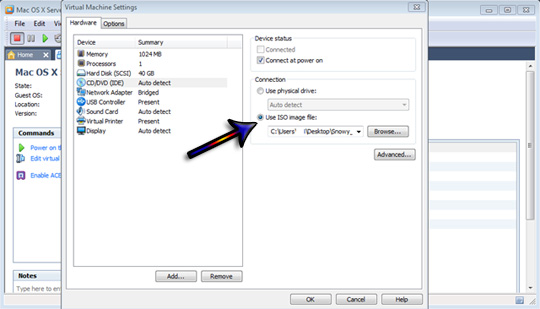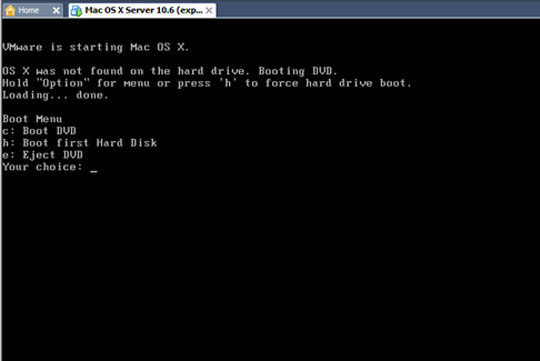Install Mac OS X Snow Leopard on a PC using VMware
Many users choose Mac not only to use OS X, but also to meet the demand for Windows operating systems. This is a strong point for Mac in the battle between Mac and PC. Apple computers can be used with Windows, or with Bootcamp and virtual machines.
So can't Windows computers run OS X? The answer is yes. But this is in contrast to the Apple-licensed and licensed user agreements. So what is presented in the following article is for educational and simulation purposes only. If you want to use OS X in the best way, buy yourself a Mac.

Minimum hardware requirements must support virtualization technology and features. It is best to use processors from the Core 2 Duo, Quad Core, or Core i7 series (if available). But the most important thing is that you must use Intel series processors, not AMD.
In this test, we will install OS X after Windows through the virtual machine system, and the most suitable application is VMware Workstation 7. If you cannot afford the Workstation 7 license, you can use it. Use the free version here with the installation file size of about 512MB:

Workstation 7 installation process is quite simple, after completing this step, we must adjust and set up VMware to install Snow Leopard. Download this file and save it somewhere on your computer. Then unzip the downloaded file (this is actually just a disk image framework, not a virus or any malicious program). VMware Workstation will use and save this format to accommodate the core of the virtual machine.
To start installing Snow Leopard, start VMware Workstation from the Start > All Programs > VMware > VMware Workstation path . Then, open File > Open and point to the archive you downloaded above named Mac OS X 10.6 Server (experimental) . Then click the Open button to start loading the required files for the virtual machine:

At the Mac OS X Server tab of the VMware Workstation window, click the virtual machine adjustment icon. Here you can change the hard drive usage, memory allocation . depending on the actual system configuration. In the CD / DVD (IDE) section under Connection, select ISO Image File and point to the Darwin_Snow.iso file in the Snowy_VM folder:

Click the Power button on this virtual machine to start using the virtual machine you have just set up. When the system has booted up, press F8 key:

At this step, you directly use the OS X Snow Leopard installation disc and insert it into the CD / DVD drive. And the following is the step of installing Snow Leopard on that virtual machine file. If you look carefully, you will see a number of icons at the bottom right, right-click the CD icon and select Settings :

In the Connection box, select the use physical drive with the Auto Detect option. Then click Save> Exit:

Go back to the boot screen and select C: Boot from DVD . Press F8 to use extension options, type -v and Enter. VMware Workstation will start installing Snow Leopard from the disk, the loading of boot files will take a few minutes:

And from this step on, you can install Snow Leopard in the usual way. Click Continue to move to step 2, here select utility applications and disk management to install (if desired). Use the hard disk partitioning utility to convert the current format to OS X Extended (Journaled). After restarting, you need to set up a few more steps to use Snow Leopard. At the CD / DVD section, we do not use the real CD / DVD drive, but return to using the Darwin_Snow.iso file in the Snowy_VM folder above:

This change will cause the virtual machine to boot Snow Leopard directly, without the installation disc. And to use Snow Leopard, you need to set up and reconfigure some functions for the system to boot completely. The above are a few steps to install and use Mac OS X Snow Leopard on a computer using a VMware program, based on the provided sample file. Your success!
You should read it
- How to Install Snow Leopard on an Intel PC
- 10 support for Snow Leopard for Admin
- Snow Leopard 3 points are hard to beat Windows 7
- Create Mac OS X Lion installation disk for Mac
- Create USB install Snow Leopard
- 11 new features of Snow Leopard
- 7 remarkable features of Snow Leopard
- Instructions for fixing errors do not install VMware Tools
May be interested
- How to buy a desktop computer
 does your computer boot long every time you use it? you tried to install a new game but found out that your graphics card is outdated? or you simply want to test the speed and reliability of the new operating system windows 7 and snow leopard.
does your computer boot long every time you use it? you tried to install a new game but found out that your graphics card is outdated? or you simply want to test the speed and reliability of the new operating system windows 7 and snow leopard. - 9 things to do after installing OS X Lion
 after lion was released on the morning of july 20, a number of people who switched from snow leopard to lion were worried to see how slow the performance was. however, after that, the situation gradually improved and disappeared.
after lion was released on the morning of july 20, a number of people who switched from snow leopard to lion were worried to see how slow the performance was. however, after that, the situation gradually improved and disappeared. - Use new Exposé features in Snow Leopard
 in mac os x 10.5, users can combine the use of exposé's application windows mode and manipulate the command-tab application by activating exposé.
in mac os x 10.5, users can combine the use of exposé's application windows mode and manipulate the command-tab application by activating exposé. - Add the Dock for Mac Snow Leopard
 the dock utility bar is a great way to store the programs you use often without going to the applications folder to find them whenever you need it.
the dock utility bar is a great way to store the programs you use often without going to the applications folder to find them whenever you need it. - How to create a Service in Snow Leopard
 in this article we will show you how to create a simple service (automator).
in this article we will show you how to create a simple service (automator). - Change the way the page rolls in Lion
 mac os x lion has changed the scrolling behavior, in contrast to snow leopard. fortunately, apple has integrated a setting that allows to change this way of scrolling.
mac os x lion has changed the scrolling behavior, in contrast to snow leopard. fortunately, apple has integrated a setting that allows to change this way of scrolling. - How to fix Not enough physical memory on VMware
 vmware is a software for creating virtual machines on a computer, enabling you to run multiple operating systems in parallel. however, when a not enough physical memory error occurs on vmware, users will not be able to install the software.
vmware is a software for creating virtual machines on a computer, enabling you to run multiple operating systems in parallel. however, when a not enough physical memory error occurs on vmware, users will not be able to install the software. - How to Install VMware Player
 this wikihow teaches you how to install vmware workstation player for windows or linux. vmware workstation player is a free pc-based tool that allows you to install and run a virtual version of another operating system in a window on your...
this wikihow teaches you how to install vmware workstation player for windows or linux. vmware workstation player is a free pc-based tool that allows you to install and run a virtual version of another operating system in a window on your... - How to Update Safari on Mac
 today's wikihow will show you how to update your safari browser so you don't get the message 'this version of safari is no longer supported'. if you use a macbook with os x 10.5 (leopard) or earlier, you must purchase a copy of os x 10.6 (snow leopard) and install it on your computer first before you can update safari.
today's wikihow will show you how to update your safari browser so you don't get the message 'this version of safari is no longer supported'. if you use a macbook with os x 10.5 (leopard) or earlier, you must purchase a copy of os x 10.6 (snow leopard) and install it on your computer first before you can update safari. - Apple invited to use iCloud with OS X 10.6 for free
 apple allows free updates from os x 10.5 leopard to 10.6 snow leopard to invite users to switch from mobileme to icloud.
apple allows free updates from os x 10.5 leopard to 10.6 snow leopard to invite users to switch from mobileme to icloud.










 Setting up Wi-Fi authentication in Windows Server 2008 - Part 1
Setting up Wi-Fi authentication in Windows Server 2008 - Part 1 Set up Wi-Fi authentication in Windows Server 2008 - Part 2
Set up Wi-Fi authentication in Windows Server 2008 - Part 2 What to back up on a Linux Home Server system?
What to back up on a Linux Home Server system? Instructions for installing Active Directory on Windows Server 2008
Instructions for installing Active Directory on Windows Server 2008 Turn off the domain password request feature in Windows Server 2003
Turn off the domain password request feature in Windows Server 2003 Install Cherokee with PHP5 and MySQL supported in Fedora 14
Install Cherokee with PHP5 and MySQL supported in Fedora 14